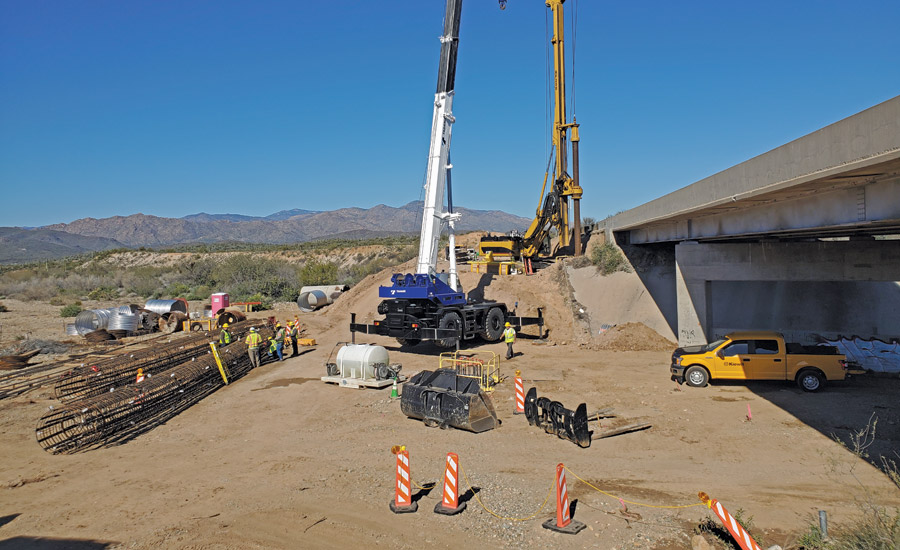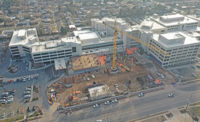For decades, commuters, holiday trippers and truck drivers have contended with a twisting eight-mile uphill stretch of Interstate 17, with ascents to 6.17% and seasonal temperatures regularly exceeding 100 degrees.
On summer weekends, traffic increases and stalls, including fully laden tractor trailers struggling with the climb, often in both lanes. Radiators overheat, drivers steam and traffic stops. And, on Sundays, as people return to the lower elevations, the congestion repeats, now on the steeply descending and twisting southbound lanes.
In Maricopa and Yavapai counties, about an hour north of Phoenix, the Arizona Dept. of Transportation (ADOT) is working on the $445.94-million I-17 Corridor-Anthem Way to Sunset Point Flex project being constructed by the Kiewit-Fann joint venture to add general purpose lanes in both directions on the high-volume I-17 from Anthem Way to Black Canyon City.
The I-17 corridor is the primary route for moving people and goods between metro Phoenix and destinations in central and northern Arizona such as Prescott, Sedona, Flagstaff and the Grand Canyon. I-17 also links I-10 in Phoenix and I-40 in Flagstaff, two of the nation’s principal east-west interstates.

An aerial view of the excavation work, and the project’s mountainous terrain.
Photo courtesy Arizona Dept. of Transportation
“This long-awaited project will provide welcome relief to a highly traveled corridor while changing the way people commute from the Phoenix metropolitan area to Arizona’s high country,” says Jennifer Toth, ADOT director.
The scope for the Kiewit-Fann joint venture’s 23-mile I-17 Improvement Project includes northbound widening on the median side and southbound widening either on the median side or on the outside, depending on terrain challenges. Following a federally required noise analysis, the team will also erect abatement walls in three sections near Anthem, New River and the Mud Springs Road exit, says Annette Riley, ADOT’s project manager.
And, on the eight hillside miles from Black Canyon City to Sunset Point, which includes a rest stop and scenic overview in the Bradshaw Mountains, the JV will replace two bridges, widen 10 others and add a flex lane system, the state’s first.
To be built adjacent to but separate from the two southbound lanes by concrete barriers, the two flex lanes will alternate to carry north- or southbound traffic depending upon general traffic and emergency needs seven days a week. Lane-transition ramps will take the vehicles from the mainline on to the two new lanes, the flex lanes. Lanes will transition to merge onto the existing lanes at the end of the flex lanes as well.
Controlled through a system that opens and closes, a sequence of flexible gates will be installed at the beginning of the flex lanes. These, along with overhead signs, will let drivers know if the flex lanes are open or not in the direction of travel.
In addition, four gates installed in line with the barrier separating the lanes will allow emergency vehicles to clear out traffic from the flex lanes and into the general-purpose lanes; these can be opened manually.
The JV team will also install vehicle net barriers to stop vehicles from proceeding in the wrong direction. ADOT’s Traffic Operations Center will control the signage and the gates.
Riley explains that ADOT decided not to build additional lanes on the existing northbound lanes from Black Canyon City to Sunset Point because the mountainous terrain would have required extensive modifications, significant disruptions, including blasting, rock falls and additional earthwork requiring lane closures. Cost was also prohibitive, she says.
About 25% complete, the project, including construction and administration, is expected to deliver in early 2025. The P3 design-build-operate-maintain (DBOM) contract, signed in late 2021 following three years of technical analysis and environmental assessment, is led by the Phoenix office of Omaha-based Kiewit Infrastructure West Co. and Prescott, Ariz.-based Fann Contracting Inc. The JV will operate the flex lane system for six months and will maintain them for three years after construction is completed. Following this, ADOT will assume these responsibilities.
The KFJV team includes DBI Services LLC; CONSOR Engineers LLC, dba Apex Design; T.Y. Lin International; Lee Engineering; Terracon Consultants Inc.; Wheat Design Group Inc.; Y2K Engineering, Pinyon Environmental Inc.; and Sturgeon Electric. Through a contract with ADOT, HDR is serving as general engineering consultant.
Funding is from various sources: $175.9 million in federal aid with matching state highway funds; $130 million from state highway funds; a $90-million Infrastructure for Rebuilding America grant; and $50 million programed by the Maricopa Association of Governments for the Maricopa County portion of the project.
“The I-17 Improvement Project will add capacity, reduce congestion and increase safety not only by widening the highway in both directions but also by adding an innovative flex lane system to move traffic safely and efficiently while clearing the congestion in an area that frequently sees back-ups,” Toth says. “These improvements will be a game-changer for daily commuters, weekend travelers and commercial truck drivers who rely on this key corridor every day.”

The widening project is needed to relieve traffic congestion, which becomes severe during summer weekends.
Photo courtesy Arizona Dept. of Transportation
First Things First
From the beginning, JV partners Kiewit and Fann agreed that they would complement each other well. Fann has experience with asphalt paving and drainage, and Kiewit has the equipment and expertise to perform the heavy excavation and bridgework, says Allen Mills, a Kiewit project director, noting that the firms, despite their difference in size, share similar company cultures.
“The biggest challenge we anticipated going in was managing and minimizing impacts to traffic during construction — especially since widenings and flex lanes would be built adjacent to interstate traffic,” he says.
ADOT and the team are carefully coordinating the work, which continues for the most part on weekdays during regular business hours. During peak weekend travel times, no scheduled lane closures are expected.
On weeknights, the blasting occurs for at most an hour later in the evening on either the north or south alignments. All of the rock is then transported to two crushing sites where they are reduced to the needed size for embankments, aggregates or rip rap for areas such as culverts.
Girder placement is also scheduled at night because of the required tight coordination and safety and quality control considerations. JV crews recently needed two nights to install the bridge deck girders on the New River bridge at Exit 232, including the largest, weighing about 22.5 tons.
In the design phase, Riley notes that ADOT and the JV team modeled the traffic for expected delays and impacts and emergency responders who might need to be accommodated despite the expected night closures. “We have received some calls a couple of times to check, but there have been no emergencies, although the process seems to be working,” she says.
To maintain work schedule, the team is designing and constructing the bridges concurrently, that is, as each one is approved, construction begins immediately so multiple bridges will be in construction simultaneously.

This rendering from the Arizona DOT shows how the I-17 corridor will be widened.
Image courtesy Arizona Dept. of Transportation
Permitting Protocols
Just as construction began in January 2022, the Army Corps of Engineers changed its 404 WOTUS permitting protocols. Overnight, the required site delineations significantly increased from four to 94.
“The Corps was very amiable under the MOU we established, and we avoided multiple iterations for its review process, but this was a huge challenge both in work hours and overall scheduling,” Riley says. She notes that this impacted the project scheduling up to six months, delaying final asphalt work to fall 2024, for example. The change will cost about an additional $32 million, Riley notes.
About the same time, the team noticed that the 19 box culverts in the project would not have the structural capacity to support the extra lanes above them. “The culverts themselves are being extended with reinforced concrete structures to essentially match what is in place already,” says Cruse.
The team found ultra-lightweight foamed glass aggregates that could be added above the culverts and compacted appropriately. This is the first time ADOT is using the recycled bottle glass product, though it’s has been effectively used by DOTs on the East Coast, Riley says.
The terrain is challenging, especially for David Gregson’s drainage crew, which must install concrete pipe up to 84 in. in diameter at the bottom of deeply sloped embankments along narrow roads carved from the hillsides with limited right-of-way. “We have crew here who have done this kind of work before, but when they see these conditions, they ask, ‘What is this?’ And I reply, ‘We’ll figure it out’,” says Gregson, Fann Contracting’s project manager.
The pandemic had and still has impacts. “In the middle of COVID-19, we decided to have safe virtual meetings when the infection rate was very high in the state,” Riley recalls. “We knew there was no benefit for anyone to be out a month.”
But everyone soon realized how important onsite teamwork and one-on-one collaboration is, so the team required face masks and sanitation and were able to work on site together and co-located designers, design managers and engineers to the onsite trailer complex.
Labor is stable, Cruse says. “We have eventually been able to get people, including a handful of specialty craft workers for our foundations group. But it may be a challenge to work our way up from where we are now, about 100, adding 30 to 40 people in the next couple months, such as equipment operators, carpenters and laborers.” The most telling factor is the robust Phoenix-area construction market, he says. “There’s so much work going on with all of the microchip factories going up, for example.”
Concrete, ready-mix and fly ash have been similarly affected. As a result, the joint venture set up its own batch plant on site to avoid overdependence on Phoenix-area facilities.
And fuel costs remain high. A few weeks ago, the cost was higher in Scottsdale than in California, says Mills.
Still, Riley expects the next three years to move smoothly. “We are all gearing up for peak construction, and we have all elements going well right now,” she says. “Our focused goal is getting open, and we are all looking forward to completing the project so that everyone can enjoy a safer, more efficient highway.”


